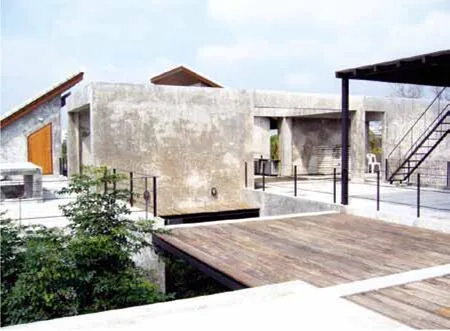十宅,曼谷,泰国
2014-02-20建筑设计致力于住所与环境建设的建筑师社团
建筑设计:致力于住所与环境建设的建筑师社团
十宅,曼谷,泰国
建筑设计:致力于住所与环境建设的建筑师社团

1.2 外景/External views
十宅是一个重新定义住宅开发的项目。通常的住宅项目不会留给中产阶级购房者很多设计和建造的选择。他们为了买一栋理想住宅积攒一生工作的积蓄,最终却住进缺乏个性的商业大楼,这实在让人遗憾。为了解决这个问题,一群泰国建筑师在1996年成立了名为“致力于住所与环境建设的建筑师社团”(英文简称CASE)的组织,他们享有共同的梦想,想要为不寻常的住宅项目找到解决方案。CASE探索设计的过程与住户个人创造力的表达之间的基本关系,并增加服务于住户特殊需求的功能。
当然,每个家庭都是独一无二的。住宅项目不只由一个房子构成,它还包含偏好各异的邻居,就此而言,让住户加入设计过程的想法是大胆而有启发作用的。从集体的角度看,每个人的偏好能够被满足到何种程度是一个挑战,因此需要集体的努力和妥协的策略来创造“一个”包含“10个”独立住宅的整理设想。
CASE所关注的概念是每个单元拥有相似建筑和建造逻辑的住宅社区。但是,每个单元的设计必须要足够有针对性地应对住户的多样需求,并反映出他们的生活方式。通过让甲方实质性地参与到设计过程中,CASE更像是一个建筑顾问,而非建筑师。但是,在将每个甲方的梦想转变为一个能够表达整个社区一致性的最终设计中,CASE的角色是至关重要的。
与大阪十宅的原始居住社区不同,曼谷十宅是一个实验项目,它的房主是中产阶级,其中部分人是建筑师,甚至是CASE的成员。作为一个个体,每个人的力量都是微弱的,但是作为一个团体,他们可以增加购买力和创造力去达成理想住宅。首先,曼谷十宅的成员、设计师和住户开始选定场地,这块场地的价格需要能被负担得起、位置需要让每个人同样方便,曼谷交通系统未来的扩张也需要被考虑进去。然后,合作设计在住户之间逐渐展开。整个项目所占据的基地被划分为10块次级基地,每个次级基地的面积是相等的。项目涉及到的每个人都要设定他们个人以及所属集体的设计和居住标准。一个人不能在不顾全他人和与他人协商的情况下简单地将自己的设计置入地段中。概念上,每个房子都要从共同的环境中生长出来。
当一个人走入其中,具有主导性的庭院是主要的空间组织者和导航者,它将每个住宅单元中迷宫般的路径统一并分隔开来。每个单元的边界在概念上是封闭的,但实际上部分单元是没有界限的,这产生了一种相互联系又不丧失私密性的感觉。十宅的最终目的不是保持实验性,而是为工薪阶层提供一个不寻常的居住解决方案。□(李若星 译)
TEN is a project that redefines the notion of housing development. Generally, residential projects do not leave middle class homebuyers many options in terms of design or construction. It's sad to think of these buyers saving money their whole working lives to buy their dream houses, but ending up with this kind of lacking in identity commercial design. In 1996, a group of Thai architects formed Community Architects for Shelter and Environment (or CASE) to address this problem. This collaboration of people of similar vision sought alternative housing project solutions. CASE explores the relationship between the design process and the desire to express the individual creativity of house owners or dwellers, generating add-on functions to serve their particular needs.
Each family is unique. The idea of involving inhabitants in the design process is daring and inspiring since housing projects do not consist of only one house, but rather a collection of neighbors with different preferences. Satisfying each of their preferences is a challenge. It requires a collaborative effort and compromise to create a unified blueprint with "ten" separate individualized homes.
CASE focuses on an ambition of a community in which each unit has a similar architectural and constructional logic. Yet, the design of each unit must be particular enough to respond to varying demands of its residents and reflect their lifestyle. By actually involving clients in the design process, CASE becomes more of an architect-consultant than an architect-designer. Still, CASE's role is crucial in transforming each client's particular vision into a final design representing the consensus of the whole community.
Unlike TEN Osaka, the original home community, TEN Bangkok is a pilot project comprising middle class homeowners some of which are architects and also members of CASE. As individuals, each remains powerless, but working as a community they can multiply their buying and creative power to achieve their ideal home. First, the working class members/designers/inhabitants of TEN Bangkok begin the site selection process.The land has to be affordable and in a location that equally convenient to all. The future expansion of Bangkok's transportation system is also taken into account. Then the design collaboration between each resident begins. The project occupies a single plot of land divided into ten subplots. The footprint of each subplot is equal. Everyone involved sets their personal and collective design and dwelling criteria. One cannot simply insert one’s design into the site without careful consideration and negotiation with the others. The goal is that each house produced on the site has the support and agreement of its neighbors.
Entering, a dominant courtyard acts as a main spatial organizer and navigator. It unites and separates the circulation of each and every unit.The boundary of each unit is fixed but also partially unbounded. There is a sense of interconnectedness without a lose privacy. The ultimate goal of the TEN is not to remain an experimental approach but to offer a generally viable alternative housing solution for working class people.□
项目信息/Credits and Data
客户/Clients: Patama Roonrakwit, Wachara Sonchaeng, Supitcha Tovivich, Nantapong Yindeekhun, Chawanad Launseng, Parnjai Jarusarn, Narttaya Kimyong, Thanida Samathapan
设计团队/Design Team: Patama Roonrakwit, Wachara Sonchaeng, Supitcha Tovivich, Nantapong Yindeekhun, Chawanad Launseng
室内设计/Interior Designers: Patama Roonrakwit, Wachara Sonchaeng, Supitcha Tovivich, Nantapong Yindeekhun
场地面积/Site Area: 936m2
建筑面积/Floor Area: 1500m2
设计时间/Design Period: 2004
摄影/Photos: Art4d

3 用于公共活动的连接平台/Connected deck for common use

4 首层平面/Floor 0 plan
评论
王彦:静谧而富有张力的模糊空间
两个或者多个家庭所共享的一系列内院空间, 处于一种介于私密与半公共的模糊状态。建筑师恰到好处地利用墙面、隔栅、天桥、栏杆等因素的设计安排,既确定了每户家庭各自的活动领域,又创造出邻里之间可以进行视觉或语言沟通的空间场所。阳光透过顶棚隔栅洒进内院,一种静谧而富有张力的气氛笼罩了4m×4m网格构架体系所营造出的丰富空间,令人赞叹。有着相同居住理想的中产阶级家庭在这里汇聚,以彼此之间的价值认同和邻里关照为基础,形成和谐而富有温情的社区关系,这些都在作品中展露无遗,令人神往。
赵扬:建筑师为自己盖房子本不稀罕,但5位建筑师为包括自己在内的8位建筑师设计集合住宅,而且从方法到结果,都呈现出一种建筑实验的开放心态,实在难能可贵。设计的工具和方法必须具有理性和灵活性,才能保证在设计的过程中,建筑和生活的信息能不断加入,让生活的丰富性和差异性本身去塑造建筑的形态。CASE的这种实践让我联想到智利建筑师亚历杭德罗·阿拉维纳领导的Elemental公司在金塔·蒙罗伊的集合住宅项目,建筑师首先通过理性的分析和判断,确定一个空间的格局,剩下的部分(包括加建的体量、部分的立面、室内的分割)由使用者去完成。所不同的是,在十宅这个项目里,虽然每个建筑师在属于自己的格子里体现了各自生活的差异,但最后还是通过统一的材料和细部做法来实现作为一个作品的完整性。紧凑的平面、材料的朴素以及细部的简洁可以看出建筑师在控制建筑形式和预算方面的努力。
Comments
WANG Yan: A Quiet Space of Great Strength
The inner courtyard space at the heart of this project is shared by two or more families and hovers between a condition of privacy and semi-publicity. The architects appropriately used design, spatial composition, barriers, overlooks and various other tools to make each unit into a home for a family and create spaces for communication-visual and oral. As sunlight penetrates through the ceiling grille, a strong tranquil atmosphere is created in the space formed by the 4×4m grid structure. In this community of middle class families with common values a warm relationship is forged. And this commonality is fully supported by every detail of the architectureimpressive and attractive.
ZHAO Yang: It is not rare for an architect to build a house for himself, but it is very brave of these five architects to design this housing complex for eight architects including themselves. From its methods to its final results, this project expresses openmindedness and a willingness to experiment. The tools and methods must be rational and flexible to ensure that the buildings can be added to incrementally over time-allowing the richness and diversity of the user's life to shape their home. This CASE project reminds me of the Chilean architect Alejandro Aravena's Quinta Monroy residential project. In this project, the spatial composition was first determined using rational analysis and judgment. The user was then allowed to complete it (adding massing, facade elements, and interior partitions). The difference between these two projects is that, although each of the CASE architects reveals the differences of each of their lives in their homes, they use unified materials and detailing to maintain the project's integrity. Its compact layout, simple materials, and concise detailing reveal the architects' efforts to control architectural forms and the budget.
TEN House, Bangkok, Thailand, 2007
Architects: Community Architects for Shelter and Environment (CASE)

5 泳池/Swimming pool

6 3号住宅正面/Front of house No.3
